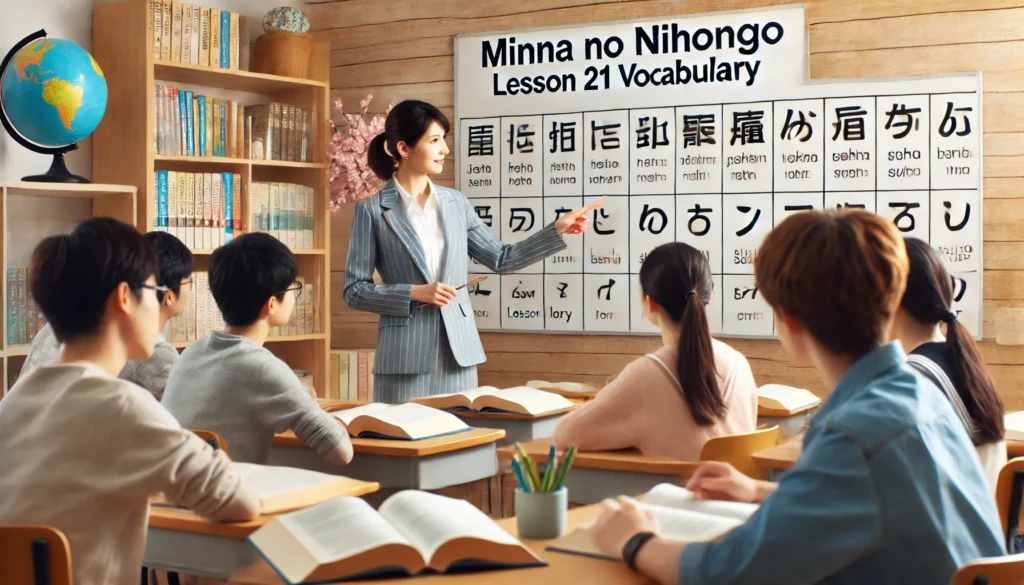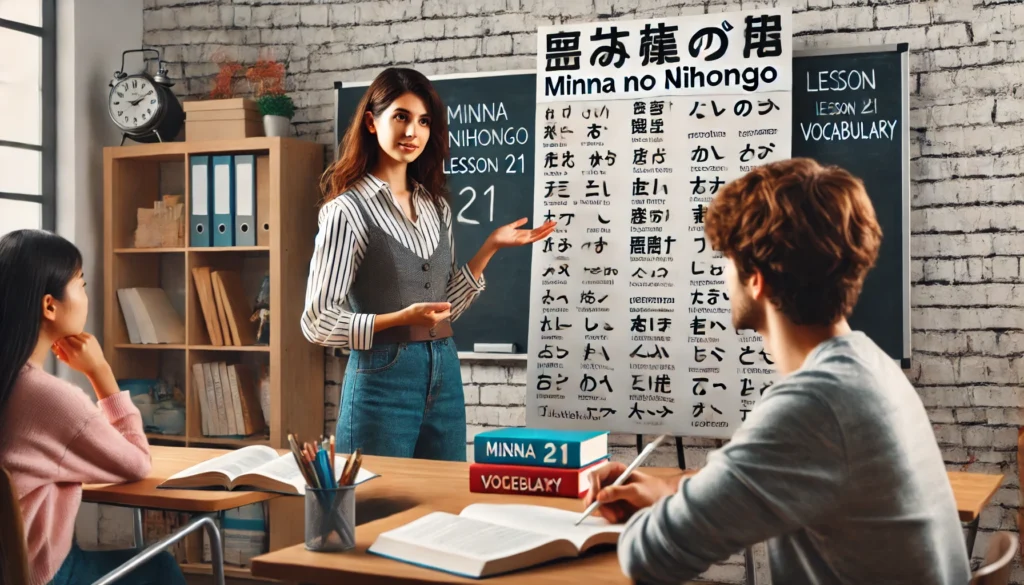Minna No Nihongo Lesson 21 Vocabulary: Comprehensive Guide and Tips for Mastery
Learning Japanese with Minna No Nihongo is a transformative experience for language enthusiasts and professionals alike. Known for its structured lessons, the textbook equips learners with essential vocabulary and grammar to navigate daily life in Japan. Lesson 21 stands out as a pivotal point where the focus shifts towards more practical and situational language, making it an invaluable chapter to master.
Minna No Nihongo Lesson 21 Vocabulary Practice.
| Romaji | Hiragana | English |
|---|---|---|
| omoimasu | おもいます | think |
| iimasu | いいます | say |
| kachimasu | かちます | win |
| makemasu | まけます | lose, be beaten |
| omatsuri | おまつり が あります | quit or retire from [a company] stop, give up |
| yakuni tachimasu | やくに たちます | be useful |
| ugokimasu | うごきます | move, work |
| yamemasu | かいしゃ を やめます | quit or retire from[a company] stop, give up |
| ki | き を つけます | pay attention, take care |
| ryuugakushimasu | りゅうがくします | study abroad |
| muda | むだ | wasteful |
| fuben | ふべん | inconvenient |
| sugoi | すごい | awful,great |
| hontou | ほんとう | true |
| uso | うそ | lie |
| jidousha | じどうしゃ | car, automobile |
| koutsuu | こうつう | transport, traffic |
| bukka | ぶっか | prices (commodity) |
| housou | ほうそう | announcement, broadcast |
| yume | ゆめ | dream |
| tensai | てんさい | genius |
| shiai | しあい | game, match |
| iken | いけん | opinion |
| hanashi | はなし | talk, speech, what one says, story |
| chikyuu | ちきゅう | earth |
| tsuki | つき | moon |
| saikin | さいきん | recently,these days |
| tabun | たぶん | probably, perhaps, maybe |
| kitto | きっと | surely, definitely |
| hontouni | ほんとうに | really |
| sonnani | そんなに | not so (used with negatives) |
| ni tsuite | -に ついて | about, concerning |
What is Minna No Nihongo Lesson 21 Vocabulary?
Lesson 21 in Minna No Nihongo delves into vocabulary that revolves around giving opinions, expressing assumptions, and discussing potential scenarios. This lesson emphasizes words and expressions that help build conversational fluency and comprehension, especially in formal or speculative contexts.
Mastering this lesson opens up opportunities to discuss topics confidently, both casually and in professional settings.

Vocabulary Breakdown
Common Nouns
The nouns introduced in Lesson 21 often relate to opinions, advice, and scenarios. For example:
- 意見 (いけん – iken): Opinion
- 会議 (かいぎ – kaigi): Meeting
- 新聞 (しんぶん – shinbun): Newspaper
Understanding these words is critical for constructing sentences about personal thoughts or events.
Essential Verbs
Action verbs form the core of communication, and Lesson 21 introduces essential ones, such as:
- 思う (おもう – omou): To think
- 言う (いう – iu): To say
- 足りる (たりる – tariru): To be enough
These verbs are vital for expressing opinions or making speculative remarks.
Adjectives and Adverbs
Adjectives and adverbs like:
- 便利な (べんりな – benrina): Convenient
- 多分 (たぶん – tabun): Probably
…are indispensable for descriptive and hypothetical statements.
Real-Life Applications
Lesson 21 vocabulary finds its way into everyday life effortlessly. Consider the following example:
- 彼はたぶん来ないと思います。
(かれはたぶんこないとおもいます。)
I think he probably won’t come.
Such practical usage underlines how this lesson’s words make daily interactions smoother and more meaningful.
Tips for Memorizing Vocabulary
1. Flashcards and Repetition
Create flashcards for each word and practice daily. Spaced repetition ensures that words stay in your long-term memory.
2. Contextual Learning
Rather than memorizing words in isolation, place them in sentences or stories to see how they function naturally.
3. Associative Techniques
Link words to visual images or similar-sounding words in your native language for better recall.
How Lesson 21 Builds on Previous Lessons
Lesson 21 is closely tied to earlier chapters, where foundational grammar and simpler vocabulary were introduced. For instance:
- Earlier lessons taught です/ます forms, which are now used with 思う for opinions.
- New vocabulary builds on this by allowing more nuanced statements.
This layered approach ensures a smooth progression in learning.
Challenges and How to Overcome Them
Some learners find certain words tricky due to similarities in pronunciation or usage. For example, confusing 足りる (tariru) with 借りる (kariru—to borrow). Practicing these words in different contexts can help mitigate errors.
Engaging Practice Methods
1. Writing Exercises
Compose daily journal entries using lesson 21 vocabulary to cement your learning.
2. Speaking Drills
Engage in role-play scenarios where you discuss opinions or hypothetical situations.
3. Interactive Tools and Resources
Use apps like Anki or Quizlet to review vocabulary interactively.
Recommended Resources
- Genki I & II: Complement Minna No Nihongo with additional explanations.
- Tae Kim’s Guide to Japanese: Excellent for grammar pairing.
- Duolingo and Anki: For flashcards and spaced repetition.
The Cultural Context of Lesson 21 Vocabulary
Lesson 21 vocabulary reflects Japan’s nuanced approach to communication. Words like 多分 (tabun) demonstrate the cultural emphasis on politeness and indirectness. Understanding these subtleties enriches your grasp of the language.
Frequently Made Mistakes
1. Pronunciation Pitfalls
Words like 新聞 (shinbun) may be mispronounced as shinban. Pay attention to intonation.
2. Misinterpretation
Confusing similar verbs like 言う (iu) and 話す (hanasu—to speak) can lead to misunderstandings. Practice distinguishing them.
Progressing Beyond Lesson 21
As you master this chapter, transition to the next lessons to tackle advanced vocabulary and grammar. Keep reviewing previous lessons to reinforce your foundation while embracing new challenges.

Conclusion
Minna No Nihongo Lesson 21 vocabulary is a critical milestone in your Japanese language journey. With its focus on practical expressions and nuanced communication, this lesson equips you with tools for real-life interactions. Stay consistent, practice diligently, and immerse yourself in the language to achieve fluency.
FAQs
What is the focus of Lesson 21 in Minna No Nihongo?
Lesson 21 emphasizes vocabulary for expressing opinions, making assumptions, and discussing scenarios.
Are there any online resources for mastering Lesson 21?
Yes, platforms like Quizlet and Anki offer tailored flashcards, while language apps provide interactive practice.
How many new words are introduced in Lesson 21?
Approximately 30–40 new words, including nouns, verbs, and adjectives.
What techniques are best for learning vocabulary quickly?
Use flashcards, write sentences, and practice conversations to enhance retention.
How does this lesson fit into the overall course?
Lesson 21 builds on prior lessons, introducing intermediate-level vocabulary and expanding conversational fluency.